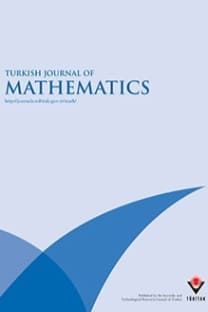A certain subclass of bi-univalent analytic functions introduced by means of the q -analogue of Noor integral operator and Horadam polynomials
A certain subclass of bi-univalent analytic functions introduced by means of the q -analogue of Noor integral operator and Horadam polynomials
___
- [1] Alamoush AG. Coefficient estimates for certain subclass of bi functions associated the Horadam polynomials. arXiv preprint arXiv:1812.10589. 2018 Dec 22.
- [2] Aldweby H, Darus M. A subclass of harmonic univalent functions associated with-analogue of Dziok-Srivastava operator. ISRN Mathematical Analysis 2013; 10: 2013.
- [3] Arif M, Haq MU, Liu JL. A subfamily of univalent functions associated with-analogue of Noor integral operator. Journal of Function Spaces 2018; 2018.
- [4] Duren PL. Univalent functions, Grundlehren der Mathematischen Wissenschaften. New York, USA: Springer, 1983.
- [5] Fekete M, Szegö G. Eine Bemerkung über ungerade schlichte Funktionen. Journal of the London Mathematical Society. 1933; 1 (2): 85-89.
- [6] Filipponi P, Horadam AF. Derivative sequences of Fibonacci and Lucas polynomials. Applications of Fibonacci Numbers 1991; 4: 99-108.
- [7] Filipponi P, Horadam AF. Derivative sequences of Fibonacci and Lucas polynomials. In: Bergum GE, Philippou AN, Horadam AF (editors) Applications of Fibonacci Numbers, vol. 4. Dordrecht, the Netherlands: Kluwer Academic Publishers, 1991, pp. 99-108.
- [8] Horadam AF, Mahon JM. Pell and Pell-Lucas Polynomials. The Fibonacci Quarterly 1985; 23 (1): 7-20.
- [9] Horzum T, Gökçen Koçer E. On some properties of Horadam polynomials. International Mathematical Forum 2009; 4: 1243-1252.
- [10] Koshy T. Fibonacci and Lucas Numbers with Applications. New York, USA: Wiley, 2019.
- [11] Lupas A. A guide of Fibonacci and Lucas polynomials. Octagon Mathematics Magazine. 1999; 7(1): 2-12.
- [12] Noor KI. On new classes of integral operators. Journal of Geometry 1999; 16 (1-2): 71-80.
- [13] Noor KI, Noor MA. On integral operators. Journal of Mathematical Analysis and Applications. 1999; 238 (2): 341-352.
- [14] Srivastava HM. Univalent functions, fractional calculus, and associated generalized hypergeometric functions. In: Srivastava HM, Owa S (editors). Univalent Functions, Fractional Calculus, and Their Applications. New York, NY, USA: Springer, 1989, pp. 329-354.
- [15] Srivastava HM, Altınkaya Ş, Yalçın S. Certain subclasses of bi-univalent functions associated with the Horadam polynomials. Iranian Journal of Science and Technology, Transactions A: Science 2019; 43 (4): 1873-1879.
- [16] Szegö G. Orthogonal Polynomials, 4th edition. American Mathematical Society Colloquium Publications, vol 23. Rhode Island, USA: American Mathematical Society, Providence, 1975.
- [17] Tingting W, Wenpeng Z. Some identities involving Fibonacci, Lucas polynomials and their applications. Bulletin mathématique de la Société des Sciences Mathématiques de Roumanie. 2012; 1: 95-103.
- [18] Vellucci P, Bersani AM. The class of Lucas-Lehmer polynomials. Rendiconti di Matematica e delle sue Applicazioni 2016; 7 (37): 43-62.
- ISSN: 1300-0098
- Yayın Aralığı: 6
- Yayıncı: TÜBİTAK
(P,Q)-Lucas polynomial coefficient inequalities of the bi-univalent function class
On ps-Drazin inverses in a ring
Huanyin CHEN, Tuğçe PEKACAR ÇALCI
Some permutations and complete permutation polynomials over finite fields
Pınar ONGAN, Burcu GÜLMEZ TEMÜR
Ali MADANSHEKAF, Zeinab KANJANZADEH
Fibonacci and Lucas numbers as products of two repdigits
Elvan AKIN, Taher S HASSAN, Özkan ÖZTÜRK, İsmail Uğur TİRYAKİ
